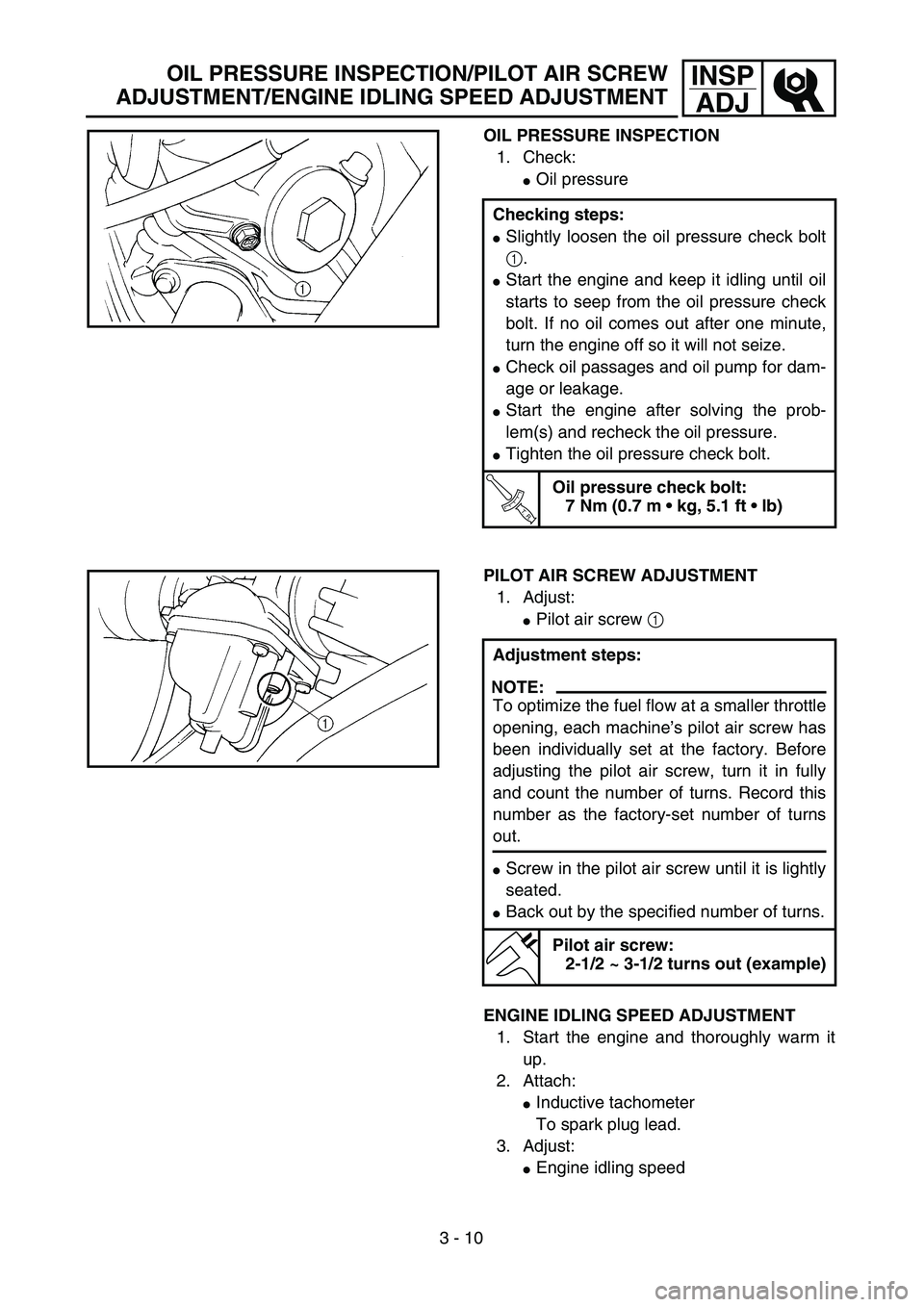Page 170 of 610

3 - 1
INSP
ADJ
MAINTENANCE INTERVALS
EC300000
REGULAR INSPECTION AND ADJUSTMENTS
MAINTENANCE INTERVALS
The following schedule is intended as a general guide to maintenance and lubrication. Bear in mind
that such factors as weather, terrain, geographical location, and individual usage will alter the
required maintenance and lubrication intervals. If you are a doubt as to what intervals to follow in
maintaining and lubricating your machine, consult your Yamaha dealer.
Dealer
NoteItem Checks and maintenance jobsInitial Every
10 hours
(1 month)60 hours
(6 months)120 hours
(12 months)
*Fuel lineCheck fuel hoses for cracks or damage.
Replace if necessary.
Spark plugCheck condition.
Clean, regap or replace if necessary.
*ValvesCheck valve clearance.
Adjust if necessary.
Air filter Clean or replace element if necessary.
*CarburetorCheck engine idling speed and starter operation.
Adjust if necessary.
Exhaust systemsCheck for leakage.
Retighten if necessary.
Replace gasket if necessary.
Engine oilCheck oil level and vehicle for oil leakage.
Correct if necessary.
Change. (Warm engine before draining.)
ClutchCheck operation.
Adjust or replace cable.
*Front brakeCheck operation.
Adjust brake lever free play.
Check fluid level and leakage.
(TT-R125LW/TT-R125LWE only)Every ride
*Rear brakeCheck operation.
Adjust brake pedal free play and replace brake
shoes if necessary.Every ride
*WheelsCheck balance, runout, spoke tightness and for
damage.
Tighten spokes and rebalance, replace if
necessary.
*TiresCheck tread depth and for damage.
Replace if necessary.
Check air pressure.
Correct if necessary.
*Wheel bearingsCheck bearing for looseness or damage.
Replace if necessary.
*SwingarmCheck swingarm pivoting point for play.
Correct if necessary.
Lubricate with molybdenum disulfide grease.
Drive chainCheck chain slack.
Adjust if necessary. Make sure that the rear wheel
is properly aligned.
Clean and lubricate.Every ride
*Steering bearingsCheck bearing play and steering for roughness.
Correct accordingly.
Lubricate with lithium soap base grease every 120
hours.
Page 176 of 610

3 - 3
INSP
ADJ
PRE-OPERATION INSPECTION AND MAINTENANCE
PRE-OPERATION INSPECTION AND MAINTENANCE
Before riding for break-in operation or practice, make sure the machine is in good operating condi-
tion.
Before using this machine, check the following points.
GENERAL INSPECTION AND MAINTENANCE
Item Routine Page
FuelCheck that a fresh gasoline is filled in the fuel tank. Check the
fuel line for leakage.P.1-12
Engine oilCheck that the oil level is correct. Check the crankcase for leak-
age.P.3-7 ~ 10
Gear shifter and clutchCheck that gears can be shifted correctly in order and that the
clutch operates smoothly.P.3-4
Throttle grip/housingCheck that the throttle grip operation and free play are correctly
adjusted. Lubricate the throttle grip and housing, if necessary.P.3-4 ~ 5
BrakesCheck the play of front and rear brake and effect of front and
rear brake.
Check fluid level and leakage. (TT-R125LW/TT-R125LWE only)P.3-15 ~ 20
Drive chainCheck chain slack and alignment. Check that the chain is lubri-
cated properly.P.3-21 ~ 22
WheelsCheck for excessive wear and tire pressure. Check for loose
spokes and have no excessive play.P.3-27 ~ 28
SteeringCheck that the handlebar can be turned smoothly and have no
excessive play.P.3-28 ~ 32
Front forks and rear shock
absorber assemblyCheck that they operate smoothly and there is no oil leakage. P.3-23 ~ 26
Cables (wires)Check that the clutch and throttle cables move smoothly. Check
that they are not caught when the handlebars are turned or
when the front forks travel up and down.—
Muffler Check that the muffler is tightly mounted and has no cracks. P.4-2
Sprocket Check that the driven sprocket tightening nut is not loose. P.3-20
Lubrication Check for smooth operation. Lubricate if necessary. P.3-33
Bolts and nuts Check the chassis and engine for loose bolts and nuts.—
Lead connectorsCheck that the CDI magneto, CDI unit, and ignition coil are con-
nected tightly.P.1-5
Page 192 of 610

3 - 10
INSP
ADJOIL PRESSURE INSPECTION/PILOT AIR SCREW
ADJUSTMENT/ENGINE IDLING SPEED ADJUSTMENT
OIL PRESSURE INSPECTION
1. Check:
�Oil pressure
Checking steps:
�Slightly loosen the oil pressure check bolt
1.
�Start the engine and keep it idling until oil
starts to seep from the oil pressure check
bolt. If no oil comes out after one minute,
turn the engine off so it will not seize.
�Check oil passages and oil pump for dam-
age or leakage.
�Start the engine after solving the prob-
lem(s) and recheck the oil pressure.
�Tighten the oil pressure check bolt.
T R..
Oil pressure check bolt:
7 Nm (0.7 m • kg, 5.1 ft • lb)
PILOT AIR SCREW ADJUSTMENT
1. Adjust:
�Pilot air screw 1
Adjustment steps:
NOTE:
To optimize the fuel flow at a smaller throttle
opening, each machine’s pilot air screw has
been individually set at the factory. Before
adjusting the pilot air screw, turn it in fully
and count the number of turns. Record this
number as the factory-set number of turns
out.
�Screw in the pilot air screw until it is lightly
seated.
�Back out by the specified number of turns.
Pilot air screw:
2-1/2 ~ 3-1/2 turns out (example)
ENGINE IDLING SPEED ADJUSTMENT
1. Start the engine and thoroughly warm it
up.
2. Attach:
�Inductive tachometer
To spark plug lead.
3. Adjust:
�Engine idling speed
Page 268 of 610
4 - 5
ENG
CARBURETOR
HANDLING NOTE
At high altitudes, the atmospheric pressure is
lower. This can make the fuel mixture too rich,
leading to such problems as fouled.
Spark plugs and slow response at high engine
speeds. A special part, High Altitude Main Jet
1
#102.5 (620-1423A-71-A0) is available to
correct this.
EC463000
REMOVAL POINTS
Throttle valve
1. Remove:
�
Throttle valve
1
�
Spring (throttle valve)
2
�
Carburetor top cover
3
�
Throttle cable
4
NOTE:
While compressing the spring (throttle valve),
disconnect the throttle cable.
Pilot air screw
1. Remove:
�
Pilot air screw
1
NOTE:
To optimize the fuel flow at a smaller throttle
opening, each machine’s pilot air screw has
been individually set at the factory. Before
removing the pilot air screw, turn it in fully and
count the number of turns. Record this number
as the factory-set number of turns out.